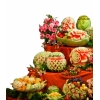|
 Every girl
in the childhood even tried to make her dish of art for holiday event under
supervision of her mom or grandmother. The ideas are so abundant that sometimes
you feel inspired to do everything you know in cooking. Or example, make a rose
from the boiled beet-root or stars from carrot or a flower from the onion.
There are lots of fascinating ideas. Those who feel
themselves creative designers to make something unusual like funny faces or puppies
or something outrageous only face the criticism followed by words that «We never
play with food» or «Do not waste food!». Every girl
in the childhood even tried to make her dish of art for holiday event under
supervision of her mom or grandmother. The ideas are so abundant that sometimes
you feel inspired to do everything you know in cooking. Or example, make a rose
from the boiled beet-root or stars from carrot or a flower from the onion.
There are lots of fascinating ideas. Those who feel
themselves creative designers to make something unusual like funny faces or puppies
or something outrageous only face the criticism followed by words that «We never
play with food» or «Do not waste food!».
Perhaps, some
advanced parents take the kids to special groups of wood carving or cross
fancy-works with the aim to teach their children think correctly and use only
simple and affordable things for their art works.
And this is
not reasonable at all! Carving (is the individual artistic work so well adopted
in cooking and well practiced in the world.
As many various
things we have to do in our routine life, food carving originated thousands
year ago in the exotic East where people appreciated not only nutrient agents
but also the appearance to enjoy. Food carving is the integral part of cookery in China,
Japan and Thailand and the carving art is the pride of local masters.
Confidential techniques are different
from region to region; the composition ideas and the ways to keep the carved things
fresh for longer time are inherited and special tools for carving cost a lot. Examining
the carved masterpieces, it is easy to define the place where the master lives since
the plot and the performance techniques reveal the entire nation with its
typical cultural and historical details. Thus, the Chinese masters tend to
carve compositions of battle or historical scenes, dragon images, mythical
animals, old times characters, heroes and congratulation signs. The Japanese technique
is similar to the Chinese and food carving is different for the sizes and color
gamut solutions. Customarily the Chinese and Japanese masters apply special clichés
and knives.
However,
the Thai food carving is the one that attracts more admirers for the tender
petals, precise and elegant carving, color ornaments, water flows of incredible
blend and it is hardly believable that this miracle is made from the radish, melon,
cabbage leaves or onions. Thai masters use the entire assortment of knives,
cutters and special nozzles. The compositions created by the Thai cutters are
really elegant, negligible and fin. Could you ever imagine that this beauty is
possible to eat later on?
Food carving
smoothly moved to creative America
from the East, and later it spread over the world. Along with the oriental
trend, the food carving is the customary thing at banquettes, functions and
events in the world.
The American
food carving is different from the oriental food carving in the artistic
performance, the same as the American wrestler differs from the Shaolin monk.
Though Americans are unique that they are capable to adopt and «digest» new
knowledge and skills, and pass from themselves and develop absolutely new kind
of human skills. Moreover, the Americans are easy to adopt this technique since
they have carving experience for Halloween. American food carving is the witty solution to
feeding problems and games of adults in the kitchen. Somehow cynic, sometimes blunt
and shut out of style, too simple (if not down-home) craft things made from scratch
(when rolls, sausages, biscuits are used) using as part of the composition of
kitchen utensils, furniture, books and others, they are remembered. You must
have seen lots of crazy images in the Internet like a funny roll carved from
the bread or an apple caught at the finger. And this is typical works of
American food carving.
Elements of
food carving are used in pedagogic study as well. The artistic carving on
fruits and vegetables is the simplest and relatively cheap method to teach
children do something with the hands with the aim to develop the fine motor
skills and grow tolerance and patience.
There are hundreds
of contests, festivals and sessions of food carvers, from professionals to amateurs,
and many reputed restaurants include in the job description of the cook the
skill of food carving. Every year thousands of people of various age, race, and
nationalities take a cutter and use it to make a masterpiece from the fruit or
vegetable. If marble is not available for carving, why not apple?
|